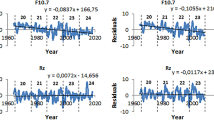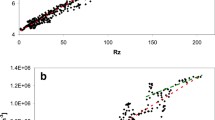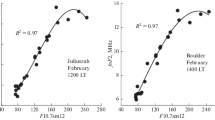Abstract
The effect of including solar cycle 23 in foF2 trend estimation is assessed using experimental values for Slough (51.5°N, 359.4°E) and Kokobunji (35.7°N, 139.5°E), and values obtained from two models: (1) the Sheffield University Plasmasphere-Ionosphere model, SUPIM, and (2) the International Reference Ionosphere, IRI. The dominant influence on the F2 layer is solar extreme ultraviolet (EUV) radiation, evinced by the almost 90% variance of its parameters explained by solar EUV proxies such as the solar activity indices Rz and F10.7. This makes necessary to filter out solar activity effects prior to long-term trend estimation. Solar cycle 23 seems to have had an EUV emission different from that deduced from traditional solar EUV proxies. During maximum and descending phase of the cycle, Rz and F10.7 seem to underestimate EUV solar radiation, while during minimum, they overestimate EUV levels. Including this solar cycle in trend estimations then, and using traditional filtering techniques, may induce some spurious results. In the present work, filtering is done in the usual way considering the residuals of the linear regression between foF2 and F10.7, for both experimental and modeled values. foF2 trends become less negative as we include years after 2000, since foF2 systematically exceeds the values predicted by a linear fit between foF2 and F10.7. Trends become more negative again when solar cycle 23 minimum is included, since for this period, foF2 is systematically lower than values predicted by the linear fit. foF2 trends assessed with modeled foF2 values are less strong than those obtained with experimental foF2 values and more stable as solar cycle 23 is included in the trend estimation. Modeled trends may be thought of as a ‘zero level’ trend due to the assumptions made in the process of trend estimation considering also that we are not dealing with ideal conditions or infinite time series.
Similar content being viewed by others
Background
Solar extreme ultraviolet (EUV) irradiance is the main ionization source of the F2 region of the Earth’s ionosphere (Tobiska 1996; Chen et al. 2012), explaining around 90% of the variance of parameters such as the critical frequency of the F2 region (foF2) and the peak height of electron concentration (hmF2). The knowledge of solar EUV variability is essential then for understanding and forecasting the variability of the ionospheric F2 region and also to determine the filtering process to assess long-term trends.
Ionospheric trends have become a main subject since the beginning of the 1990s when the study of upper atmosphere trends gained importance in the context of global climatic change (Roble 1995; Ulich and Turunen 1997). Several studies link ionospheric trends with the middle and upper atmosphere cooling due to an increase in greenhouse gases (Roble and Dickinson 1989; Rishbeth 1990; Upadhyay and Mahajan 1998; Hall and Cannon 2002). A doubling in CO2 concentration would produce a cooling of 30 to 40 K in the thermosphere, a 20% to 40% decrease in air density between 200 and 300 km, an approximately 15- to 20-km lowering of the ionospheric F2 peak height (hmF2), and a worldwide decrease in the F2 critical frequency (foF2) of less than 0.5 MHz (Roble and Dickinson 1989; Rishbeth 1990; Rishbeth and Roble 1992). However, the global pattern of experimental hmF2 and foF2 of several worldwide stations is highly complex and cannot be entirely reconciled with the greenhouse hypothesis. Some reasons for this are as follows: On one side, other sources of upper atmosphere trends exist (such as geomagnetic activity long-term variation and Earth’s magnetic field secular variations), which act jointly with the greenhouse effect. On the other side, the methods used to extract trend values differ from author to author and usually rely on some filtering process that may bias the trend results.
Since there are no long-term continuous measurements of solar EUV, different indices are used to describe the variations of solar EUV irradiance and to filter ionospheric parameters in order to assess long-term variations. Among these indices, F10.7 and Rz are the most widely used.
Solar cycle 23 minimum, between 2007 and 2009, is characterized by lower EUV solar radiation emission than previous solar cycles (Solomon et al. 2010, 2013) and, in addition, different than that deduced from traditional solar EUV proxies such as Rz and F10.7. Emmert et al. (2010) suggested that the long-term relationship between EUV irradiance and F10.7 has changed markedly since around 2006 with EUV levels decreasing more than expected from the F10.7 proxy. This result is also suggested by Chen et al. (2011). The opposite happened to the relationship between EUV and Rz during solar cycle 23 maximum and declining phase, where Rz underestimates EUV solar radiation (Lukianova and Mursula 2011). In addition, Rz and F10.7, which were used interchangeably as EUV proxy, present a significant change in their relationship since solar cycle 23 (Tapping and Valdes 2011). Since the most common filtering technique used in foF2 trend estimation relies on a constant association between foF2 and the corresponding EUV proxy, a failure in this assumption may end in wrong results.
foF2 time series from Slough (51.5°N, 359.4°E) and Kokobunji (35.7°N, 139.5°E) that include solar cycle 23 are analyzed in the present work in order to detect their effect on trend estimations. The experimental results are compared to trends assessed with foF2 obtained from the Sheffield University Plasmasphere-Ionosphere Model (SUPIM) (Bailey et al. 1997) and from the International Reference Ionosphere (IRI) (Bilitza and Reinisch 2008). The ‘Data analysis’ section describes the data and the filtering procedure together with the results obtained. Results and discussion are presented in the ‘Results and discussion’ section.
Methods
The monthly median critical frequency of the F2 layer (foF2) for the month of July at 12 LT from Slough (51.5°N, 359.4°E) and Kokobunji (35.7°N, 139.5°E) is analyzed for the period covering solar cycles 20 to 23, together with foF2 obtained for the same period and stations from two models: SUPIM (Bailey et al. 1997) and IRI (Bilitza and Reinisch 2008). Both models use a solar activity index as a proxy for the solar EUV radiation. In the case of SUPIM, the solar EUV fluxes are computed from the EUV94 solar EUV flux model which uses daily values of Lyman-alpha, He I, and F10.7. The IRI model uses the global ionospheric index IG12 which presents a variation similar to Rz.
The first step in order to assess trends is to filter out the influence of solar activity on the ionosphere. This is done by estimating the foF2 residuals from the regression between the experimental values and the solar activity index F10.7, that is
where a and b are constants determined with least squares.
Then, a regression of foF2res with time is adjusted with least squares so that
where α and β are the regression coefficients, and α (in MHz/year) is the trend we are interested in.
Results and discussion
The trend α is estimated first for the period 1964 to 1994, and then 1 year is added successively until reaching 2008. Figure 1 shows these trend values, all significant at a 95% level, for Slough and Kokobunji for July at 12 LT. In the case of experimental trend values, they are negative first and become less negative as solar cycle 23 is included in the trend estimation. They reach the least negative trend in 2001, and then trends drop to the most negative trends in 2004 and again turn to less negative towards 2007 to 2008. Note that F10.7 for year 2001 presents a deep minimum to which foF2 seems not to respond. This fact may explain the almost ‘abrupt’ change in foF2 trend values (see Figure 1) and also validates the fact that during solar cycle 23 maximum, F10.7 seems to underestimate EUV solar radiation. During the descending phase, F10.7 for 2004 presents a small hump, again not followed by foF2 which would explain in this case a pronounced negative trend value for the period 1964 to 2004.
Trend values. foF2 trend [MHz/year] for (a) Slough and (b) Kokobunji, July 12 LT, assessed for experimental foF2 data (triangles). Also shown are modeled trends for SUPIM foF2 (empty circle) and IRI foF2 (filled circle). The period of each trend value begins in 1964 and ends in the year indicated by the abscissa.
Towards the end of cycle 23 (years 2007 to 2008), F10.7 is supposed to overestimate EUV, and trends, including these years, become more negative than trends without these years. This can be clearly seen in Table 1 which presents trend values assessed for the periods 1964 to 1994, 1964 to 2002, and 1964 to 2008. The first one does not include solar cycle 23, and for experimental trend values, in the case of Kokobunji, it is clearly more negative than the other two periods.Figure 1 also shows SUPIM and IRI foF2 trends considering F10.7 as EUV proxy. Trends in the case of SUPIM are in almost all cases statistically non-significant. In the case of IRI, trends are stronger but still smaller than in the experimental case. The common thing between both modeled trends is the higher stability as each year is added in the calculation.
Conclusions
The filtering of ionospheric data series is an essential ‘first step’ previous to long-term trend estimation. If F10.7 is not a correct indicator of EUV variability, a ‘spurious’ trend would be obtained, that is a trend with ‘no real’ physical cause. Equally important is the correct presentation of solar EUV effect on the ionosphere. For example, for very intense solar cycles, such as solar cycle 19, a saturation effect appears and the linearity breaks down for F10.7 greater than 200 sfu (Liu et al. 2011).
When trends are assessed with experimental foF2 data including solar cycle 23, care must be taken with the filtering method used. As shown in this work, the underlying ‘true’ trend value can be affected by the filtering process due to solar EUV emissions during this solar cycle which are not well represented by F10.7.
Lastovicka (2013) demonstrated that yearly values of foF2 are overestimated by F10.7 in 2008 to 2009. He also found weaker (more positive) trends in foF2 in 1995 to 2010 compared with 1976 to 1996. Luhr and Xiong (2010) compared measurements of the CHAMP and GRACE satellites in the years 2000 to 2009 with the IRI-2007 predictions and found that the electron density values of the IRI-2007 model track the measurements reasonably well during the period 2000 to 2004 but overestimate the observations in the later period, although in general ionospheric parameters are adequately modeled by IRI (Oyekola and Fagundes 2012; Oyekola 2012).
Regarding trend values shown in Table 1, they are of the order of the decreasing trend expected from the greenhouse gas effect. The greatest trends expected from this effect can be assessed from Qian et al. (2009) who obtained −40% as a maximum NmF2 trend due to a doubling in CO2. This means a −18% to −20% in foF2. Making a linear extrapolation to the real 20% increase in CO2 (instead of the 100% used in the models) and assuming a 10-MHz average value foF2 give a −0.008 to 0.009 MHz decrease in foF2.
Trends obtained with modeled data, which do not consider in their formulation the long-term cooling of the thermosphere due to the greenhouse effect, could be thought of as zero level trends. That is a trend threshold due to errors inherent to the filtering method and due to the time series finite length. Table 1 presents the trends obtained from subtracting modeled trends from experimental trends. In both cases, and for both stations, trend absolute values decrease approaching the value expected from anthropogenic effect.
References
Bailey GJ, Balan N, Su YZ: The Sheffield University Ionosphere-Plasmasphere model. A review. J Atmos Terr Phys 1997, 59: 1541–1552. 10.1016/S1364-6826(96)00155-1
Bilitza D, Reinisch B: International Reference Ionosphere 2007: improvements and new parameters. Adv Space Res 2008, 42: 599–609. doi:10.1016/j.asr.2007.07.048
Chen Y, Liu L, Wan W: Does the F10.7 index correctly describe solar EUV flux during the deep solar minimum of 2007–2009? J Geophys Res 2011. doi:10.1029/2010JA016301
Chen Y, Liu L, Wan W: The discrepancy in solar EUV-proxy correlations on solar cycle and solar rotation timescales and its manifestation in the ionosphere. J Geophys Res 2012., 117: doi:10.1029/2011JA017224
Emmert JT, Lean JL, Picone JM: Record-low thermospheric density during the 2008 solar minimum. Geophys Res Lett 2010., 37: doi:10.1029/2010GL043671
Hall CM, Cannon PS: Trends in foF2 above Tromso. Geophys Res Lett 2002., 29: doi:10.1029/2002GL016259
Lastovicka J: Are trends in total electron content (TEC) really positive? J Geophys Res 2013, 118: 3831–3835. doi:10.1002/jgra.50261
Liu L, Wan W, Chen Y, Le H: Solar activity effects of the ionosphere: a brief review. Chinese Sci Bull 2011, 56: 1202–1211. doi:10.1007/s11434–010–4226–9
Luhr H, Xiong C: IRI‒2007 model overestimates electron density during the 23/24 solar minimum. Geophys Res Lett 2010, 37: L23101. doi:10.1029/2010GL045430
Lukianova R, Mursula K: Changed relation between sunspot numbers, solar UV/EUV radiation and TSI during the declining phase of solar cycle 23. J Atmos Sol Terr Phys 2011, 73: 235–240. 10.1016/j.jastp.2010.04.002
Oyekola OS: Equatorial vertical plasma drifts and the measured and IRI model-predicted F2-layer parameters above Ouagadougou during solar minimum. Earth Planets Space 2012, 64: 577–593. 10.5047/eps.2011.10.008
Oyekola OS, Fagundes PR: On the variations of ionospheric parameters made at a near equatorial station in the African longitude sector: IRI validation with the experimental observations. Earth Planets Space 2012, 64: 567–575. 10.5047/eps.2011.10.004
Qian L, Burns AG, Solomon SC, Roble RG: The effect of carbon dioxide cooling on trends in the F2-layer ionosphere. J Atmos Sol Terr Phys 2009, 71: 1592–1601. doi:10.1016/j.jastp.2009.03.006
Rishbeth H: A greenhouse effect in the ionosphere? Planet Space Sci 1990, 38: 945–948. 10.1016/0032-0633(90)90061-T
Rishbeth H, Roble RG: Cooling of the upper atmosphere by enhanced greenhouse gases. Modeling of the thermospheric and ionospheric effects. Planet Space Sci 1992, 40: 1011–1026. 10.1016/0032-0633(92)90141-A
Roble RG: Major greenhouse cooling (yes, cooling): the upper atmosphere response to increased CO2. Rev Geophys 1995, 33: 539–546.
Roble RG, Dickinson RE: How will changes in carbon dioxide and methane modify the mean structure of the mesosphere and thermosphere? Geophys Res Lett 1989, 16: 1441–1444. 10.1029/GL016i012p01441
Solomon SC, Woods TN, Didkovsky LV, Emmert JT, Qian L: Anomalously low solar extreme‒ultraviolet irradiance and thermospheric density during solar minimum. Geophys Res Lett 2010., 37: doi:10.1029/2010GL044468
Solomon SC, Qian L, Burns AG: The anomalous ionosphere between solar cycles 23 and 24. J Geophys Res 2013, 118: 6524–6535. doi:10.1002/jgra.50561
Tapping KF, Valdes JJ: Did the Sun change its behavior during the decline of cycle 23 and into cycle 24? Sol Phys 2011, 272: 337–350. 10.1007/s11207-011-9827-1
Tobiska WK: Current status of solar EUV measurements and modeling. Adv Space Res 1996, 18: 3–10. doi:10.1016/0273–1177(95)00827–2
Ulich T, Turunen E: Evidence for long-term cooling of the upper atmosphere in ionosonde data. Geophys Res Lett 1997, 24: 1103–1106. 10.1029/97GL50896
Upadhyay HO, Mahajan KK: Atmospheric greenhouse effect and ionospheric trends. Geophys Res Lett 1998, 25: 3375–3378. 10.1029/98GL02503
Acknowledgements
We would like to thank two anonymous reviewers for their helpful comments and to the Nagoya CAWSES-II Symposium organizers for the important financial support they gave to Ana G. Elias and for the publication of this article. This research was performed under project Prestamo BID - PICT 2011–1008.
Author information
Authors and Affiliations
Corresponding author
Additional information
Competing interests
The authors declare that they have no competing interests.
Authors’ contributions
KS provided Kokobunji data. JRS and BFHB did the SUPIM calculations. AGE did the statistical analysis. All authors participated in the design of the study and read and approved the final manuscript.
Authors’ original submitted files for images
Below are the links to the authors’ original submitted files for images.
Rights and permissions
Open Access This article is distributed under the terms of the Creative Commons Attribution 4.0 International License (https://creativecommons.org/licenses/by/4.0), which permits use, duplication, adaptation, distribution, and reproduction in any medium or format, as long as you give appropriate credit to the original author(s) and the source, provide a link to the Creative Commons license, and indicate if changes were made.
About this article
Cite this article
Elias, A.G., de Haro Barbas, B.F., Shibasaki, K. et al. Effect of solar cycle 23 in foF2 trend estimation. Earth Planet Sp 66, 111 (2014). https://doi.org/10.1186/1880-5981-66-111
Received:
Accepted:
Published:
DOI: https://doi.org/10.1186/1880-5981-66-111





